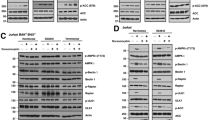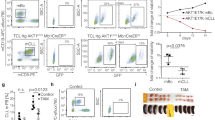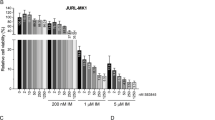Abstract
The cytotoxic farnesyl transferase inhibitor BMS-214662 has been shown to potently induce mitochondrial apoptosis in primitive CD34+ chronic myeloid leukaemia (CML) stem/progenitor cells. Here, to enhance the BMS-214662 apoptotic effect, we further targeted the extracellular signal-regulated kinase (ERK) pathway, downstream of BCR–ABL, by treating CD34+ CML stem/progenitor cells with a highly selective adenosine triphosphate (ATP) non-competitive MEK inhibitor, PD184352. PD184352 increased the apoptotic effect of BMS-214662 in a CML blast crisis cell line, K562, and in primary chronic phase CD34+ CML cells. Compared with BMS-214662, after combination treatment we observed inhibition of ERK phosphorylation, increased Annexin-V levels, caspase-3, -8 and -9 activation and potentiated mitochondrial damage, associated with decreased levels of anti-apoptotic BCL-2 family protein MCL-1. Inhibition of K-RAS function by a dominant-negative mutant resulted in CML cell death and this process was further enhanced by the addition of BMS-214662 and PD184352. Together, these findings suggest that the addition of a MEK inhibitor improves the ability of BMS-214662 to selectively target CML stem/progenitor cells, notoriously insensitive to tyrosine kinase inhibitor treatment and presumed to be responsible for the persistence and relapse of the disease.
This is a preview of subscription content, access via your institution
Access options
Subscribe to this journal
Receive 12 print issues and online access
$259.00 per year
only $21.58 per issue
Buy this article
- Purchase on Springer Link
- Instant access to full article PDF
Prices may be subject to local taxes which are calculated during checkout






Similar content being viewed by others
References
Rowley JD . Letter: a new consistent chromosomal abnormality in chronic myelogenous leukaemia identified by quinacrine fluorescence and Giemsa staining. Nature 1973; 243: 290–293.
Daley GQ, Van Etten RA, Baltimore D . Induction of chronic myelogenous leukemia in mice by the P210bcr/abl gene of the Philadelphia chromosome. Science 1990; 247: 824–830.
Druker BJ . Translation of the Philadelphia chromosome into therapy for CML. Blood 2008; 112: 4808–4817.
Hughes T, Branford S . Molecular monitoring of chronic myeloid leukemia. Semin Hematol 2003; 40: 62–68.
Bhatia R, Holtz M, Niu N, Gray R, Snyder DS, Sawyers CL et al. Persistence of malignant hematopoietic progenitors in chronic myelogenous leukemia patients in complete cytogenetic remission following imatinib mesylate treatment. Blood 2003; 101: 4701–4707.
Chu S, Allen L, Tinisha M, David S, Stephen F, Ravi B . Persistence of leukemia stem cells in chronic myelogenous leukemia patients in complete cytogenetic remission on imatinib treatment for 5 years. Blood (ASH Annu Meet Abstr) 2008; 112: 194
Weisberg E, Manley PW, Breitenstein W, Broggen J, Cowan-Jacob SW, Ray A et al. Characterization of AMN107, a selective inhibitor of native and mutant Bcr-Abl. Cancer Cell 2005; 7: 129–141.
Shah NP, Tran C, Lee FY, Chen P, Norris D, Sawyers CL . Overriding imatinib resistance with a novel ABL kinase inhibitor. Science 2004; 305: 399–401.
Nicaise C, Wang X, Roy A, Pfister M, Chen T-T, Bleickardt E et al. Dasatinib pharmacokinetics and exposure-response: relationships to efficacy and safety in patients with chronic myelogenous leukemia in chronic phase (CML-CP). Haematologica (EHA Annu Meet Abstr) 2008; 93: 227.
Copland M, Hamilton A, Elrick LJ, Baird JW, Allan EK, Jordanides N et al. Dasatinib (BMS-354825) targets an earlier progenitor population than imatinib in primary CML but does not eliminate the quiescent fraction. Blood 2006; 107: 4532–4539.
Jorgensen HG, Allan EK, Jordanides NE, Mountford JC, Holyoake TL . Nilotinib exerts equipotent antiproliferative effects to imatinib and does not induce apoptosis in CD34+ CML cells. Blood 2007; 109: 4016–4019.
Mahon FX, Rea D, Guilhot J, Guilhot F, Huguet F, Nicolini F et al. Discontinuation of imatinib in patients with chronic myeloid leukaemia who have maintained complete molecular remission for at least 2 years: the prospective, multicentre Stop Imatinib (STIM) trial. Lancet Oncol 2010; 11: 1029–1035.
Gajate C, Mollinedo F . The antitumor ether lipid ET-18-OCH(3) induces apoptosis through translocation and capping of Fas/CD95 into membrane rafts in human leukemic cells. Blood 2001; 98: 3860–3863.
Copland M, Pellicano F, Richmond L, Allan EK, Hamilton A, Lee FY et al. BMS-214662 potently induces apoptosis of chronic myeloid leukemia stem and progenitor cells and synergizes with tyrosine kinase inhibitors. Blood 2008; 111: 2843–2853.
Pellicano F, Copland M, Jorgensen HG, Mountford J, Leber B, Holyoake TL . BMS-214662 induces mitochondrial apoptosis in chronic myeloid leukemia (CML) stem/progenitor cells, including CD34+38- cells, through activation of protein kinase Cbeta. Blood 2009; 114: 4186–4196.
Jorgensen HG, Allan EK, Graham SM, Godden JL, Richmond L, Elliott MA et al. Lonafarnib reduces the resistance of primitive quiescent CML cells to imatinib mesylate in vitro. Leukemia 2005; 19: 1184–1191.
Nguyen TK, Rahmani M, Harada H, Dent P, Grant S . MEK1/2 inhibitors sensitize Bcr/Abl+ human leukemia cells to the dual Abl/Src inhibitor BMS-354/825. Blood 2007; 109: 4006–4015.
Yu C, Krystal G, Varticovksi L, McKinstry R, Rahmani M, Dent P et al. Pharmacologic mitogen-activated protein/extracellular signal-regulated kinase kinase/mitogen-activated protein kinase inhibitors interact synergistically with STI571 to induce apoptosis in Bcr/Abl-expressing human leukemia cells. Cancer Res 2002; 62: 188–199.
Lorusso PM, Adjei AA, Varterasian M, Gadgeel S, Reid J, Mitchell DY et al. Phase I and pharmacodynamic study of the oral MEK inhibitor CI-1040 in patients with advanced malignancies. J Clin Oncol 2005; 23: 5281–5293.
Barrett SD, Bridges AJ, Dudley DT, Saltiel AR, Fergus JH, Flamme CM et al. The discovery of the benzhydroxamate MEK inhibitors CI-1040 and PD 0325901. Bioorg Med Chem Lett 2008; 18: 6501–6504.
Graham SM, Jorgensen HG, Allan E, Pearson C, Alcorn MJ, Richmond L et al. Primitive, quiescent, Philadelphia-positive stem cells from patients with chronic myeloid leukemia are insensitive to STI571 in vitro. Blood 2002; 99: 319–325.
Chou TC, Talalay P . Quantitative analysis of dose-effect relationships: the combined effects of multiple drugs or enzyme inhibitors. Adv Enzyme Regul 1984; 22: 27–55.
Matallanas D, Arozarena I, Berciano MT, Aaronson DS, Pellicer A, Lafarga M et al. Differences on the inhibitory specificities of H-Ras, K-Ras, and N-Ras (N17) dominant negative mutants are related to their membrane microlocalization. J Biol Chem 2003; 278: 4572–4581.
Cowley S, Paterson H, Kemp P, Marshall CJ . Activation of MAP kinase kinase is necessary and sufficient for PC12 differentiation and for transformation of NIH 3T3 cells. Cell 1994; 77: 841–852.
Coffer PJ, Koenderman L, de Groot RP . The role of STATs in myeloid differentiation and leukemia. Oncogene 2000; 19: 2511–2522.
Okutani Y, Kitanaka A, Tanaka T, Kamano H, Ohnishi H, Kubota Y et al. Src directly tyrosine-phosphorylates STAT5 on its activation site and is involved in erythropoietin-induced signaling pathway. Oncogene 2001; 20: 6643–6650.
Aichberger KJ, Mayerhofer M, Krauth MT, Skvara H, Florian S, Sonneck K et al. Identification of mcl-1 as a BCR/ABL-dependent target in chronic myeloid leukemia (CML): evidence for cooperative antileukemic effects of imatinib and mcl-1 antisense oligonucleotides. Blood 2005; 105: 3303–3311.
Copland M, Hamilton A, Allan EK, Brunton V, Holyoake TL . BMS-214662 targets quiescent chronic myeloid leukaemia stem cells and enhances the activity of both imatinib and dasatinib (BMS-354825). Blood (ASH Annu Meet Abstr) 2005; 106: 693.
Holyoake T, Jiang X, Eaves C, Eaves A . Isolation of a highly quiescent subpopulation of primitive leukemic cells in chronic myeloid leukemia. Blood 1999; 94: 2056–2064.
Fukuchi Y, Kizaki M, Yamato K, Kawamura C, Umezawa A, Hata J et al. Mcl-1, an early-induction molecule, modulates activin A-induced apoptosis and differentiation of CML cells. Oncogene 2001; 20: 704–713.
Yu C, Rahmani M, Almenara J, Subler M, Krystal G, Conrad D et al. Histone deacetylase inhibitors promote STI571-mediated apoptosis in STI571-sensitive and -resistant Bcr/Abl+ human myeloid leukemia cells. Cancer Res 2003; 63: 2118–2126.
Acknowledgements
We thank Dr R Weinmann and Dr F Lee (Bristol–Myers Squibb) for providing BMS-214662 and BMS-225975, Professor C Marshall for the DN-MEK1 plasmid and Dr D Matallanas-Gomez for the K-RAS N17 plasmid. FP received funding from Bristol–Myers Squibb, the Rockefeller Foundation, Chief Scientific Office and Glasgow Royal Infirmary Endowments. PS received funding from the Ministry of Education of Czech Republic MSM-0021622430 and NPVII (2B06052). GVH and AS received funding from Biotechnology and Biological Sciences Research Council and Medical Research Council. MC received funding from Scottish Funding Council (SCD/04) and Chief Scientist's Office for Scotland Leukaemia Research Trust for Scotland. SG received funding from the NCI (CA 100866-01, CA93738-05) and the Leukemia and Lymphoma Society of America (LSA-6181-10). We would like to thank all UK CML patients and normal donors, haematologists and non-medical staff who have contributed to our biobank.
Author Contributions
FP designed the research. FP, PS, AS and GVH performed the experiments and analyzed the data. TLH and MC provided suggestions in experimental design. FP, PS and TLH co-wrote the paper. TLH supervised the project. SG provided PD184352. All authors commented on the paper.
Author information
Authors and Affiliations
Corresponding author
Ethics declarations
Competing interests
TLH receives per year approximately $10 000 combined from consultancy, speaking fees, honoraria and service on advisory boards from Bristol–Myers Squibb and Novartis. TLH also received research funding from Bristol-Myers Squibb. MC has undertaken consultancy work for Bristol–Myers Squibb and is on its Advisory Board and has received honoraria from both Bristol–Myers Squibb and Novartis within the last 2 years. The remaining authors declare no conflict of interest.
Rights and permissions
About this article
Cite this article
Pellicano, F., Šimara, P., Sinclair, A. et al. The MEK inhibitor PD184352 enhances BMS-214662-induced apoptosis in CD34+ CML stem/progenitor cells. Leukemia 25, 1159–1167 (2011). https://doi.org/10.1038/leu.2011.67
Received:
Revised:
Accepted:
Published:
Issue Date:
DOI: https://doi.org/10.1038/leu.2011.67
Keywords
This article is cited by
-
A superior loading control for the cellular thermal shift assay
Scientific Reports (2022)
-
DYRK2 controls a key regulatory network in chronic myeloid leukemia stem cells
Experimental & Molecular Medicine (2020)
-
Predicting Drug Combination Index and Simulating the Network-Regulation Dynamics by Mathematical Modeling of Drug-Targeted EGFR-ERK Signaling Pathway
Scientific Reports (2017)
-
Natural course and biology of CML
Annals of Hematology (2015)
-
Signal Transduction in the Chronic Leukemias: Implications for Targeted Therapies
Current Hematologic Malignancy Reports (2013)



